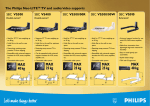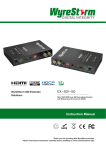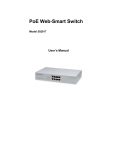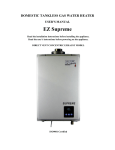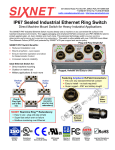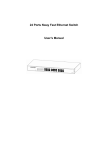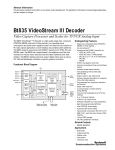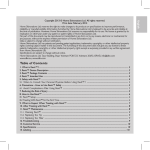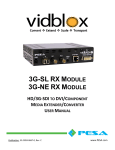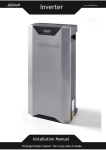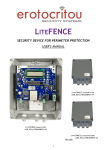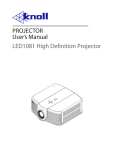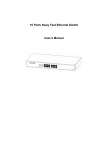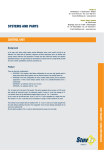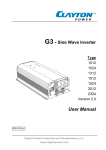Download 2.6 Overview of Video Formats
Transcript
AN1002 - HDBaseT Installation and Cabling Topics Important Notice This document may not be photocopied. This document may only be released to companies who have signed a Non-Disclosure Agreement with Valens Semiconductor Ltd. specifically regarding the VS010 or VS100 product families. Valens reserves the right to make corrections, modifications, enhancements, improvements and other changes to its products and services at any time and to discontinue any product or service without notice. Customers must obtain the latest relevant information before placing orders and must verify that such information is current and complete. All products are sold subject to Valens’s terms and conditions of sale supplied at the time of order acknowledgment. Valens does not warrant performance of its hardware and software products except to the specifications applicable at the time of sale in accordance with Valens’s standard warranty. Testing and other quality control techniques are used to the extent Valens deems necessary to support this warranty. Except where mandated by government requirements, testing of all parameters of each product is not necessarily performed. Valens assumes no liability for applications assistance or customer product design. Customers are responsible for their products and applications using Valens components. To minimize the risks associated with customer products and applications, customers must provide adequate design and operating safeguards. Valens does not warrant or represent that any license, either expressed or implied, is granted under any Valens patent, copyright, mask work right or other Valens intellectual property right relating to any combination, machine or process in which Valens products or services are used. Information published by Valens regarding third-party products or services does not constitute a license from Valens to use such products or services or a warranty or endorsement thereof. Use of such information may require a license from a third party under the patents or other intellectual property of the third party or a license from Valens under the patents or other intellectual property of Valens. Valens products are not designed, intended or authorized for use as components in systems intended for surgical implantation into the body or other applications intended to support life or for any other application in which the failure of the Valens product may result in personal injury or death. Should the Buyer purchase or use Valens products for any such unintended or unauthorized application, the Buyer shall indemnify and not hold responsible Valens and its officers, employees, subsidiaries, affiliates and distributors against all claims, costs, damages and expenses and attorney fees arising out of, directly or indirectly, any claim of personal injury or death associated with such unintended or unauthorized use, even if such claim alleges that Valens was negligent regarding the design or manufacture of the part. Reproduction of information in Valens data books or datasheets is permissible only if reproduction is without alteration and is accompanied by all associated warranties, conditions, limitations and notices. Reproduction of this information with alteration is an unfair and deceptive business practice. Valens is not responsible or liable for such altered documentation. Resale of Valens products or services with statements different from or beyond the parameters stated by Valens for that product or service voids all express and any implied warranties for the associated Valens product or service and is an unfair and deceptive business practice. Valens is not responsible or liable for any such statements. HDBaseT™ and the Valens logo are trademarks of Valens Semiconductor. All other trademarks are the property of their respective owners. Copyright © 2012, Valens Semiconductor Ltd. Version 1.0 – Confidential i Revision History Revision Date Author Description 0.1 5/12/12 Danny Raz Created 1.0 16.12.12 Danny Raz Release version Glossary ii Term Definition HD High Definition HDMI High Definition Multimedia Interface TMDS Transition Minimized Differential Signaling UTP Unshielded Twisted Pair STP Shielded Twisted Pair FEXT Far End Crosstalk NEXT Near End Crosstalk AN1002 – Installation and Cable Topics Contents 1 Overview ......................................................................................................................... 5 1.1 Document Scope .............................................................................................................. 5 1.2 Audience .......................................................................................................................... 5 1.3 Related Materials ............................................................................................................. 5 2 Understanding HDBaseT Limitations ................................................................................ 6 2.1 Overview.......................................................................................................................... 6 2.2 System Considerations...................................................................................................... 6 2.3 Overview of Video Formats ............................................................................................... 7 2.4 Understanding Cables, Cable Grades and Cable Impairments ........................................... 11 2.4.1 Cable Shield Types ..........................................................................................................11 2.4.2 Cable Grades ..................................................................................................................12 2.4.3 Cable Impairments .........................................................................................................12 2.5 Working in Full-reach and Full capacity ........................................................................... 14 2.6 Working in Long Reach Mode.......................................................................................... 14 3 Field / Lab Issues ........................................................................................................... 15 3.1 Overview........................................................................................................................ 15 3.2 Cable Layout................................................................................................................... 15 3.3 Using Patch Cables.......................................................................................................... 15 3.4 Measuring Cable Length on Existing Cabling .................................................................... 16 3.5 Field RJ45 Terminations .................................................................................................. 16 3.6 Working with Bundles .................................................................................................... 18 3.7 Lab Testing Cable Setups ................................................................................................. 19 3.7.1 Rolled Cable FEXT (Far End Cross-Talk) ..........................................................................19 3.7.2 Recommended Lab Orderly Rolling................................................................................20 Version 1.0 iii AN1002 - HDBaseT Installation and Cabling Topics 1 Overview This section includes the following topics: Document Scope Audience Related Materials 1.1 Document Scope This document provides information on installation and cabling related issues in an HDBaseT video system. It helps understand the common limitations and issues that must be understood when installing an HDBaseT link. 1.2 Audience AV equipment Installers using HDBaseT products System/Testing engineers involved in designing, manufacturing and testing HDBaseT certified products 1.3 Related Materials Valens eVS1 User Manual Valens VS100/010 Product Family Datasheet VS100 Application Note AN1033 – Update Parameter Tool UM" Version 1.0 5 2 Understanding HDBaseT Limitations 2.1 Overview This section includes the following topics: System Considerations Overview of Video Formats Understanding Cables, Cables Grades and Cable Impairments Working in Full Reach and Fully Capacity Working in Long Reach Mode 2.2 System Considerations When installing an HDBaseT system, the systems specification must be well defined in order to guarantee correct performance. The following issues must be considered: Which video formats should the system support o What is the maximum video rate / pixel clock rate? What cable types/grades are available o Does the installation use existing in-wall cables for an HDBaseT network o If yes, what grade? Length? o Are the cables laid out in a straight manner? o Is there excess cabling? Are you using a VS100 or VS010 embedded product? Are there any noise sources in the cable environment? o Fluorescent lights, Microwave, WiFi AP Are patch cables used? o What type? o How long is the total cable run (including the patches) This application note will help you understand these issues and avoid unexpected installation related problems. 6 AN1002 – Installation and Cable Topics 2.3 2.4 Summery of VS100 and VS010 Capabilities VS100 can deliver up to 10.2 Gbps of HDMI 1.4 traffic (including HDCP). Table 1 below specifies the VS100 limitations with respect to range, video format and cable grade. Table 1: VS100 Range Specification Cable Type Range Pixel clock rate Video Data Rate Supported Video CAT5e/CAT6 100 m <=225 MHz <= 5.3 Gbps Up to 1080p, 60 Hz, 36 bpp (HD Video) (data rates lower than 5.3 Gbps or below 225 MHz TMDS clock). > 5.3 Gbps 1080p 60 Hz 48 bpp, 1080p 60 Hz 3D, and 4K2K, 30Hz video formats 70 m CAT6a/CAT7(*) >225 MHz 100 m (Ultra HD Video) (*) refer to Error! Reference source not found. for a list of approved cables tested in Valens for ultraHD 100 meter reach capacity In The VS010 family is a low cost alternative to the VS100 chip family. In terms of AV link capacilities, this chip can also deliver 10.2 Gbs f HDMI 1.4 traffic (including HDCP) but for up to 70 meter range. Table 2 below specifies the VS010 capabilities: Table 2: VS010 Range Specification Cable Type Range Pixel clock rate Video Data Rate Supported Video CAT5e/CAT6 60 m <=225 MHz <= 5.3 Gbps Up to 1080p, 60 Hz, 36 bpp (HD Video) (data rates lower than 5.3 Gbps or below 225 MHz TMDS clock). > 5.3 Gbps 1080p 60 Hz 48 bpp, 1080p 60 Hz 3D, and 4K2K, 30Hz video formats 35 m >225 MHz (Ultra HD Video) CAT6a/CAT7(*) 70 m 40 m <=225 MHz >225 MHz <= 5.3 Gbps Up to 1080p, 60 Hz, 36 bpp (HD Video) (data rates lower than 5.3 Gbps or below 225 MHz TMDS clock). > 5.3 Gbps 1080p 60 Hz 48 bpp, 1080p 60 Hz 3D, and 4K2K, 30Hz video formats (Ultra HD Video) Version 1.0 7 2.5 Overview of Video Formats below, commonly used video formats are specified with their attributes. Ultra-HD formats are highlighted. In these formats, you should be aware to use proper cable if you wish to use a 100 meter cable or limit your installation to 70 meters if you use CAT5e/CAT6 cables. The VS010 family is a low cost alternative to the VS100 chip family. In terms of AV link capacilities, this chip can also deliver 10.2 Gbs f HDMI 1.4 traffic (including HDCP) but for up to 70 meter range. Table 2 below specifies the VS010 capabilities: Table 2: VS010 Range Specification Cable Type Range Pixel clock rate Video Data Rate Supported Video CAT5e/CAT6 60 m <=225 MHz <= 5.3 Gbps Up to 1080p, 60 Hz, 36 bpp (HD Video) (data rates lower than 5.3 Gbps or below 225 MHz TMDS clock). > 5.3 Gbps 1080p 60 Hz 48 bpp, 1080p 60 Hz 3D, and 4K2K, 30Hz video formats 35 m >225 MHz (Ultra HD Video) CAT6a/CAT7(*) 70 m 40 m <=225 MHz >225 MHz <= 5.3 Gbps Up to 1080p, 60 Hz, 36 bpp (HD Video) (data rates lower than 5.3 Gbps or below 225 MHz TMDS clock). > 5.3 Gbps 1080p 60 Hz 48 bpp, 1080p 60 Hz 3D, and 4K2K, 30Hz video formats (Ultra HD Video) 8 AN1002 – Installation and Cable Topics 2.6 Overview of Video Formats Table 3: Commonly Used Video Formats and Their Attributes (most data is taken from CEA-861-E standard) Rate FPS 24 25 30 Hactive 1280 1280 1280 24 1920 25 1920 30 50 50 1920 720 1280 50 50 50 50 50 50 50 50 50 50 1920 1440 1440 1440 1440 2880 2880 2880 2880 1440 50 50 1920 2880 50 60 60 60 1920 640 720 1280 60 60 60 60 60 1920 1440 1440 1440 2880 60 1920 60 2880 100 100 1920 1280 Version 1.0 Vblank 30 30 30 rate Gbps 1.4 1.8 1.8 Pixel Freq MHz 59 74 74 1125 45 1.8 74 720 1125 45 1.8 74 2200 864 1980 280 144 700 1125 625 750 45 49 30 1.8 0.6 1.8 74 27 74 I I P P P I P P P P 2640 1728 1728 1728 1728 3456 3456 3456 3456 1728 720 288 288 288 288 576 576 576 576 288 1125 625 312 313 314 625 312 313 314 625 23 25 24 25 26 25 24 25 26 49 1.8 0.6 0.6 0.6 0.7 1.3 1.3 1.3 1.3 1.3 74 27 27 27 27 54 54 54 54 54 24 24 P P 2640 3456 720 576 1125 625 45 49 3.6 2.6 149 108 24 24 24 24 I P P P 2304 800 858 1650 384 160 138 370 1250 525 525 750 85 45 45 30 1.7 0.6 0.6 1.8 72 25 27 74 24 24 24 24 24 I I P P I 2200 1716 1716 1716 3432 280 276 276 276 552 1125 525 262 263 525 23 23 22 23 23 1.8 0.6 0.6 0.6 2.6 74 27 27 27 54 24 P 2200 280 1125 45 3.6 149 24 P 3432 552 525 45 2.6 108 24 24 I P 2640 1980 720 700 1125 750 23 30 3.6 3.6 149 149 Vac tive 720 720 720 108 0 108 0 108 0 576 720 108 0 576 288 288 288 576 288 288 288 576 108 0 576 108 0 480 480 720 108 0 480 240 240 480 108 0 Color Depth 24 24 24 Prog/ Inter P P P Htotal 3300 3960 3300 Hblank 2020 2680 2020 Vtotal 750 750 750 24 P 2750 830 24 P 2640 24 24 24 P P P 24 24 24 24 24 24 24 24 24 24 480 108 0 720 9 Rate FPS 100 100 Hactive 720 1440 100 1920 120 120 120 120 1920 1280 720 1440 120 1920 30 4096 30.0 10 4096 Vac tive 576 576 108 0 108 0 720 480 480 108 0 216 0 216 0 Vblank 49 25 rate Gbps 1.3 1.3 Pixel Freq MHz 54 54 1125 45 7.1 297 280 370 138 276 1125 750 525 525 23 30 45 23 3.6 3.6 1.3 1.3 149 149 54 54 2200 280 1125 45 7.1 297 2200 280 1125 45 1.8 74 8.1 297 Color Depth 24 24 Prog/ Inter P I Htotal 864 1728 Hblank 144 288 Vtotal 625 625 24 P 2640 720 24 24 24 24 I P P I 2200 1650 858 1716 24 P 24 P 24.0 P AN1002 – Installation and Cable Topics 2.7 Understanding Cables, Cable Grades and Cable Impairments 2.7.1 Cable Shield Types Figure 1 shows three cable types designated U/UTP, F/UTP and S/FTP. U/UTP: A balanced cable type with four twisted-pair conductors surrounded by a cable sheath F/UTP: A balanced cable type with all four twisted conductor pairs enclosed by a metal foil surrounded by a cable sheath S/FTP: A balanced cable type with each of the four-twisted conductor pairs enclosed by a foil screen and a braid screen. All is surrounded by a cable sheath Figure 1: CATx Cable Types Version 1.0 11 2.7.2 Cable Grades CAT5e/CAT6: Class E cabling specification (also referred to as Cat5e and Cat6) defines balanced cabling characteristics over a maximum bandwidth of 250 MHz. The improved performance of Cat6 over Cat5E is attributed mainly to better insulation, thus lowering Attenuation, NEXT and FEXT impairments in cables and connectors. Cat6A CAT6A is sometimes referred to as Class EA. This class cable is defined to work at frequencies up to 625MHz. It reduces the NEXT and FEXT impairments by 80%, and has 27% better Insertion loss. CAT6A features increased diameter (0.31inch vs. 0.22inch), and an installed separator for controlling the pair positions within the cable. Cat6A also has an increased twist rate and varied twist rates between the four pairs, thus improving signal coupling. CAT7 Category 7 S/FTP cabling specification (also referred to Class F) defines balanced cabling characteristics over a maximum bandwidth of 1000 MHz. 2.7.3 Cable Impairments To understand the limitations of an HDBaseT system, we explain below the main impairments that occur during high throughput transmission over a CATx cable. In CATx cables there are four twisted pair channels. Each one of the four receivers suffer from impairments resulting from the three remote transmitters of the neighboring channels, and from all four transmitters on the near-end side. The following diagram shows impairments created over the four twisted pair channels (designated A, B, C and D from top to bottom) in a single CATx cable: 12 AN1002 – Installation and Cable Topics Where: o Insertion Loss (IL) - Attenuation of a signal traveling down a single pair in the cable. o FEXT (Far End Cross Talk) impairments caused by the far - end transmitters of channels D (bottom channel), C and B onto the receiver of channel A (top left). o NEXT (Near End Cross Talk) impairments: From the near - end transmitters of channels D, C & B onto the receiver of channel A. o Echo impairment: caused by an echo of the near end side transmission of channel A onto the receiver of channel A. Figure 2: Single cable impairments When installing a bundle of cables, additional impairments effects are introduced. This is shown in Figure 3 below: Figure 3: Multiple Cable Impairments Version 1.0 Alien NEXT (ANEXT): The interference that comes out on the near end of the other pairs, when a signal is injected on a pair in the central cable. 13 Alien FEXT (FEXT): The interference that comes out on the far end of the other pairs, when a signal is injected on a pair in the central cable. 2.8 Working in Full-reach and Full capacity In order to support the Ultra-HD formats listed in table Error! Reference source not found., you must guarantee that either cable lengths are <= 70 meters or a CAT6a/CAT7 cable are used if a full reach of 100 meter reach is required. The following cable models were successfully tested at Valens QA labs. We recommended these cables for use in cases when full-reach and full capacity are required (i.e. video formats with TMDS clock rate >225 MHz). You may use similar or superior grade cables but we strongly recommend testing them in advance. Table 4: Recommended Cables for Ultra-HD video at 100 Meter range Type P/N Manufacturer CAT7 S/FTP FR-LSZH Teldor http://www.teldor.com/ CAT6A H-STP HFFR Teldor http://www.teldor.com/ CAT.7 2170475 Earthline http://products.lappgroup.com/online-catalogue/datacommunication-systems-for-ethernet-technology/ 2.9 Working in Long Reach Mode The VS100 chip family support long reach mode. When this mode is applied, a more robust modulation technique is used in order to enhance range while compromising on maximum supported rate. If your system is not required to support video rates higher than 3 Gbps (i.e. 1080p, 24 bpp, 60 Hz or video formats not exceeding a pixel clock rate of 148 MHz ), you may activate long reach mode and enjoy longer cable reach of 150 meters with a CAT5e/CAT6 cable. To configure the VS100RX and VS100TX for working in long reach mode, please refer to "Valens VS100 Application Note AN1033 – Update Parameter Tool UM" NOTE: Working in long reach mode is not an HDBaseT certified mode. Interoperability issues may occur when connecting equipment from different vendors. 14 AN1002 – Installation and Cable Topics 3 Field / Lab Issues 3.1 Overview This section includes the following topics: Cable Layout Using Patch Cables Measuring Cable Length on Existing Cabling Field RJ45 Termination Working with Bundles Lab Testing Cable Setups 3.2 Cable Layout It is recommended to stretch a cable to its full length between the HDBaseT Transmitter and Receiver devices. Random rolls of excess cable will degrade the performance and should be avoided. However, sometimes the cable is rolled randomly in small turns for convenience (mainly for demo or testing purposes). Note that the maximum lengths will be reduced in this scenario. 3.3 Using Patch Cables The total run of an HDBaseT cable installation may include up to two patch cables, typically as connections to RJ45 wall jacks. This is referred to as a three-segment installation. This is shown in figure 4. Version 1.0 15 100 meters X Z Y Figure 4: Three-segment Installation The HDBaseT standard specifies the following configuration for the three-segment cable installation: Cables Length: X = Left side patch cable length ≤ 5 [meter] Y = right side patch cable length ≤ 5 [meter] Z = wall segment ≤ 100 – X – Y [meter] 3.4 Measuring Cable Length on Existing Cabling Cable lengths can be measured in the field using either a professional test equipment (like fluke DTS Cable Analyzer) or by using the VS100 length measurement feature. To learn more about reading the cable length using the VS100 length measurement feature, refer to the VSMS User Manual or the AN1004 on host interface. 3.5 Field RJ45 Terminations One of the advantages of transmitting AV over a CATx cable is the ability to terminate the cable in the field during the installation. We strongly recommend eliminating excess cable length to avoid turns and corners that may degrade the signal link quality and affect the range or video quality. 16 AN1002 – Installation and Cable Topics The VS100 chip family supports three RJ45 configurations: Straight Crossover Semi-crossover This is shown in the figure below: EIA568A RJ45 Paring A B C D streight A B C D A B C D 1 2 3 4 5 6 7 8 B A C D pair C pair A pair B pair D A B C D Semi-crossover A B D C A B C D B A D C crossover Figure 5: Supported RJ45 Configurations Version 1.0 17 3.6 Working with Bundles HDBaseT alliance defines the maximum number of cables in a bundle use case to be six. Table 5 below defines the maximum number of cables in a bundle as a function of cable type & the overlapping length. Table 5: HDBaseT Cable Permit able Number of Cables in a Bundle Type 30m 50m 70m 100m Cat5e/6 6 4 2 1 Cat6a/7 6 6 6 6 The following three cable types shown in Figure 6 are recommended to support the HDBaseT over bundling of several cables. 18 AN1002 – Installation and Cable Topics Figure 6: Cable types Recommended For Bundles The following installation practices improve alien crosstalk headroom when using Cat5E/6 cables: Do not “comb” of “pinstripe” cables in the first 20 meters. Separate path and equipment cords in the first 20m. Avoid tie-wraps. Use horizontal wire management techniques (e.g. route odd ports to upper management and even ports to lower management). Loosely place cables in vertical wire management. Reduce maximum conduit fill density to 40%. Implementation of these practices is not required for any augmented Cat6a F/UTP (sometimes referred to as ScTp) or Cat7 S/FTP (fully shielded) cabling systems. In addition, these practices do not need to be applied when using augmented Cat6a UTP systems, such as those with cable diameter design enhancements that increase cable-to-cable separation. 3.7 Lab Testing Cable Setups 3.7.1 Rolled Cable FEXT (Far End Cross-Talk) In a typical installation the cable is stretched to its full length between the HDBaseT transmitter and receiver. However in some cases, especially in demonstrations or in a lab environment, the cable is rolled randomly in small turns for convenience. The randomly rolled UTP cable suffers additional signal impairments (compared to a straight cable) and therefore the maximal operating reach might be reduced. Rolling a cable randomly causes the coupling between the various turns to create additional paths for cross talk. Therefore, the FEXT impairment is increased. This phenomenon does not occur in STP or FTP cables due to the shielding that prevents such coupling. Figure 7 illustrates three measurements taken with the same 100m CAT5E cable using a FLUKEDTX cable analyzer. Version 1.0 19 Figure 7: Power accumulated FEXT vs Cable usage In the 1st measurement the cable was spread along a 100m straight line. In the 2nd measurement it was rolled in a random way and in the 3rd it was rolled in an orderly manner. The FLUKE-DTX tested the ratio between the signals’ attenuation and the Power Sum FEXT (PSACR-F) for each of the 4 twisted pairs. In this example it is apparent that the PS-ACR-F of the randomly rolled cable (marked Random Rolled) is degraded by approximately 10dB to 20dB with respect to a spread cable (marked Spread). The reduction in the Signal to Noise Ratio (SNR) results in reduced performance (higher BER). Since there are many ways to roll such a long cable the level of performance degradation cannot be predicted Therefore, to be on the safe side, when a CAT5E cable is randomly rolled it is recommended to limit its length to approximately 50 meters. 3.7.2 Recommended Lab Orderly Rolling It is recommended to roll the cable around a fixed radius drum in an orderly manner. This is shown on the left hand side of Figure 8. When the turns are made in order the coupling between the various sections that occur in a randomly rolled cable is reduced. Rolling a CAT5E cable around a 70cm fixed diameter plastic drum has just a minor effect on the FEXT when compared to a fully stretched cable. 20 AN1002 – Installation and Cable Topics Order Rolled (3rd experiment) Random Rolled (2 nd experiment) Figure 8: Orderly and randomly Rolling a Cable Version 1.0 21






















